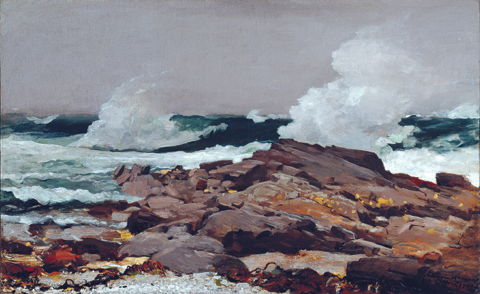
'EASTERN POINT' Oil on canvas by Winslow Homer, 30.25 by 48.5 inches, 1900.
|
"Weatherbeaten: Winslow Homer and Maine," a show of more than 30 Homer works depicting Maine and the sea, commemorates the opening the newly-restored Homer studio on Prouts Neck. The studio, very close to the shore, had been in lamentable condition for years. Now it's open to visits and very much the way it was when he was using it.
The show has gathered paintings, watercolors, and prints of Maine that are rarely seen here, among which are a number of unquestionable masterpieces that demonstrate not only Homer's method but also the drama that pervades virtually his whole body of major works.
My first ever attempt to write about visual art was an English assignment early in high school, looking at a reproduction of Homer's "Gulf Stream" (not in this show), an iconic image of a man in a dismasted sloop missing its rudder, after a storm. He lies on the pitching deck watching the sharks surrounding his boat. My penciled essay considered the man's plight in light of a naive schoolboy's expectation of an ideal, and solved the issue to my satisfaction. It is, by the way, the only work from school I can remember. I got goosebumps when I finally saw the original in New York.
Over the years, steeped in modernism as I was, my attention to Homer was tangential at best — appreciative but not deeply interested. That changed when I got an assignment to review the big (some 230 works) retrospective in Boston in 1996. While a number of the pieces made just after his Civil War reportage experience had a genre feel to them, it wasn't long before he found his stride as an artist who could reach real depth, integrating his technical ability with a broad and powerful emotional narrative. His works ring with a sense of what is really there, how it looks, and how it affects the observer.
I was once called upon to discuss Homer's life and work in the Prouts Neck studio as a between-sessions diversion for, if memory serves, a gastroenterologists' conference. I was a third-string pinch hitter, the organizers' early choices having been otherwise engaged. It was cold and dark in the studio back then, but I did my best. I got into a discussion with a doctor about how Homer's technique was not realistic but was convincing none the less. He said my assertion was nonsense; he lived on the Maine coast and it looked just the way it is in the paintings. Since his income was undoubtedly a few orders of magnitude larger than mine I ceded the point, as was appropriate under the circumstances. This is America, after all.